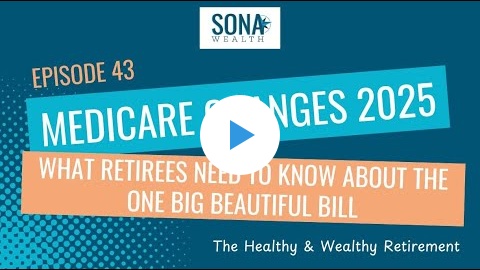|
What retirees should know about 2026 Medicare changes, shrinking networks, and how to avoid costly coverage mistakesInsights from my recent Healthy & Wealthy Retirement conversation with healthcare expert Matt Wicklund Most people approaching retirement make the same two costly health-insurance mistakes: 1️⃣ They shop only on premium, and 2️⃣ They don’t verify whether their doctors and specialists are in network. Those oversights often lead to higher total costs and unpleasant surprises—especially as new legislation and expiring subsidies reshape coverage rules. Below is a summary of the key points Matt Wicklund shared in our discussion. 1️⃣ Mistake #1: Shopping Only on PremiumA lower monthly premium can hide a much higher max-out-of-pocket (MOOP) limit. That means you might “save” $100 per month but risk paying tens of thousands if you actually need care. Tip: Compare total cost of care—premium + deductible + copays + expected use. A plan that looks cheaper rarely is if you need even moderate care. 2️⃣ Mistake #2: Not Checking the NetworkMany retirees confirm their primary doctor is in network but forget about specialists. The second-most-frequent doctor is often the one that’s out of network—triggering those “surprise” bills. Quick fix: Before you enroll, list your PCP, specialists, clinic, and hospital, then confirm each is covered by that exact plan (and year). 3️⃣ HSA Plans Are Powerful—But Only If FundedHigh-deductible health plans (HDHPs) paired with HSAs can work well, but only if you’ve built roughly $10k–$15k in the HSA. Underfunded HSAs often backfire in the first year a claim hits. 4️⃣ The “Big Beautiful Bill”: What to Watch for in 2026Matt Wicklund explained that the new “Big Beautiful Bill” (OBB) and the expiration of the Inflation Reduction Act’s enhanced premium tax credits could reshape costs in 2026.
Because these provisions are still being implemented, it’s best to treat them as watch items and build flexibility into your financial plan. 5️⃣ Medicare Basics in a Minute
Matt stressed that one-time income events—like large Roth conversions or stock sales—can trigger IRMAA surcharges two years later, so coordinate with your advisor before year-end. 6️⃣ Retiring Soon? Timing Matters
(And remember: Social Security and Medicare don’t call or email you first. If you get a “Medicare” phone call, hang up and verify by mail.) 7️⃣ Why Your County Still MattersPremiums and networks are set by rating areas (often county lines). Metro areas offer more choice and competition; rural counties may see higher costs and less access. If you’re moving for retirement, include health-care access in your location analysis along with taxes and housing. 8️⃣ Work with a Broker—It Costs the SameYou pay the same premium whether you buy directly or through a broker. A broker adds value by verifying your providers and prescriptions, handling claims issues, and re-shopping each year as plans change. As Matt put it: “If an insurer isn’t coming to your kitchen table when things go wrong, make sure your broker will.” 🟩 TakeawayYou don’t have to navigate health insurance alone. Ask questions, verify your network, and plan for the total cost—not just the premium. Doing the heavy lifting now prevents bigger surprises later and sets you up for a healthier, wealthier, and happier retirement. 🔗 Next Steps with Sona Wealth
DisclosuresSona Financial LLC, DBA Sona Wealth and Sona Wealth Advisors, is a registered investment adviser with the state of Minnesota. All views, expressions, and opinions included in this communication are subject to change. This communication is not intended as an offer or solicitation to buy, hold, or sell any financial instrument or investment advisory services. Any information provided has been obtained from sources considered reliable, but we do not guarantee the accuracy or completeness of any description of securities, markets, or developments mentioned. If you don’t have a plan and would like to get one, schedule an Intro Meeting:
To health and wealth! Mark Struthers, CFA, CFP®, CRC®, RMA® For current clients looking for a meeting:
This commentary is provided for general information purposes only, should not be construed as investment, tax, or legal advice, and does not constitute an attorney/client relationship. Past performance of any market results is no assurance of future performance. The information contained herein has been obtained from sources deemed reliable, but is not guaranteed. |

Healthcare Expert Matt Wicklund on Recent Medicare Changes and the Biggest Health-Insurance Mistakes Retirees Make
Categories
- 401k
- Backdoor Roth
- Bitcoin
- College Funding
- Crypto
- Economics
- Estate Planning
- Featured
- Feel Good
- Financial Planning
- Healthcare
- healthcare
- HSA
- Inflation
- Insurance
- Investing
- IRA
- Mega Backdoor Roth
- Open Enrollment
- Podcast
- Private Equity
- Retire Early
- Retirement
- Roth IRA
- SEPP
- Social Security
- Student Loans
- Taxes
- Traditional IRA
- Uncategorized
Share this post:
If you don’t have a plan and would like to get one, schedule a Discovery Meeting:
To health and wealth!
Mark Struthers, CFA, CFP®, CRC®, RMA®
For current clients looking for a meeting:
This commentary is provided for general information purposes only, should not be construed as investment, tax, or legal advice, and does not constitute an attorney/client relationship. Past performance of any market results is no assurance of future performance. The information contained herein has been obtained from sources deemed reliable, but is not guaranteed.
